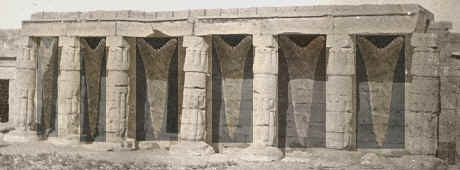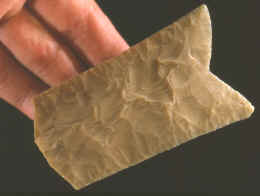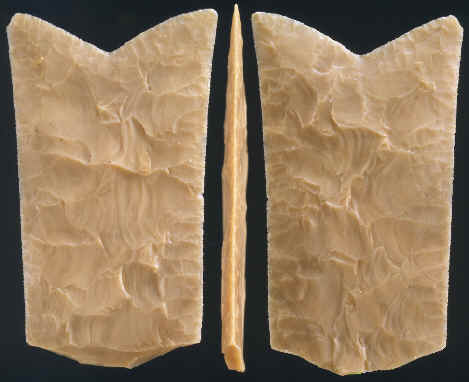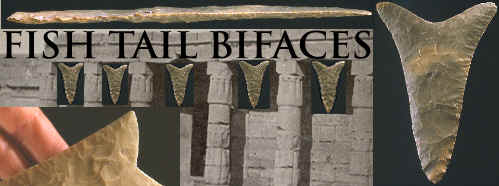|
ABSTRACT:

1903 PICTURE OF
"RUINS AT THEBES"
PLUS THE ADDED
EFFECT OF GHOSTLY IMAGES OF THE MUCH MORE ANCIENT FISH TAIL BIFACES BETWEEN
THE COLUMNS
The Fish Tail bifaces described in this article are or at least were
in three different collections. Two are in private collections and
another was borrowed from the Buffalo Museum of Science. These are
fairly rare objects that were used in religious ceremonies. They were
used in ancient Egypt thousands of years ago----long before the first pyramids
were constructed. |
"The Arabs near
Cairo have for some time been selling flint implements of new types from
the Fayum"----Heywood Walter
Seton-Karr, of the British Military Service in Egypt 1903.

THE WORKING END OF A FISH
TAIL BIFACE
EGYPT
PRIVATE COLLECTION
FISH TAIL BIFACES
The statement above, "The Arabs near Cairo have for some time
been selling flint implements of new types from the Fayum",
was made a hundred years ago by a man in the British Military Service in
Egypt. He brought back several artifacts from that area, one of which was
a fish tail biface. It was around this time that British archaeologists
like Finders Petrie and Gertrude Canton-Thompson, and others, began investigating and
describing a large variety of Predynastic (Naqada culture) stone tools found on ancient
sites like the Fayum area southwest of Cairo. The Fayum area is a
depression in the land that once contained a large fresh water lake.
Today, the lake is called Birket el Qarun and its shrinking area of water
has become salty and undrinkable. But long before the pyramids were ever
built people were living along its ancient lake shore. These early Stone Age people evolved
through several different cultures and left behind stone tools that are still
being studied today.
|

CLICK ON
PICTURE FOR LARGER IMAGE
FISH TAIL BIFACE
PREDYNASTIC--NAQADA
CULTURE
EGYPT
LEN & JANIE
WEIDNER COLLECTION
This Fish Tail biface represents a product made by a highly skilled craftsman.
It was made by using percussion flaking for the initial shaping
& bifacial
thinning (the very large flake scars) and pressure flaking for the fine
edge shaping & additional thinning (the smaller flake scars). It was made at a time when stone tool making in
Egypt had reached a golden age of flintknapping. This example has
a U shaped base and is probably an earlier style (A.J. Arkell 1975
p.46). It measures 4 1/2
inches (11.4cm) long, 2 15/16 inches (7.5cm) wide and 3/16 of an inch
(5mm) thick. |
By
far, most of the Predynastic (Naqada culture) and the early Dynastic
period stone artifacts that were made by flint knapping were utilitarian
and used for normal every day jobs. They are common and have been found in
great abundance. They include such things as various types of scrapers,
hoes for digging, large percussion flaked curved knives, denticulate tools
(saw edged---having small teeth), etc., etc.
|

CLICK ON
PICTURE FOR LARGER IMAGE
FISH TAIL BIFACE
EGYPT
PRIVATE COLLECTION
This is a broken "working end" of a very finely crafted
Fish Tail biface. If you enlarge the picture you will be able to see
the expertly done pressure flaking on the edges. This Fishtail
biface has the distinctive V shaped blade that is representative of a
later style (A.J.
Arkell 1975 p.46). This form may
still have been in use well into the early Dynastic
period and for some time after Gerzean knives were being
made. This example measures 3 3/8 inches (8.6cm) long, 2 inches
(5.1cm) wide and slightly over 3/16 of an inch (6mm) thick. |
What always stands out
are the items that are more rarely seen and may illustrate the highest
skill level for a particular craft. In this case flintknapping. The
Predynastic (Naqada culture) and very early Dynastic period Egyptian flintknappers
were some of the best any culture has ever produced to this day. If you
consider the time they took to make some of the things they did such as
Gerzean knives----with the polishing process etc., some would argue that
they were the best.
|
CONTINUE ON TO PAGE
TWO
|
|
"REFERENCES"
1904,
"Flint Implements of the Fayum, Egypt---Annual Report of The
Smithsonian Institution" by Heywood Walter ---------Seton-Karr,
pp747-751.
1969,
"The Excavations At Helwan", by Zaki Y. Saad,
pp. 43, 128 &129.
1975, "The Prehistory of the Nile Valley", by A. J. Arkell, p.
46.
1984, "Egypt Before The Pharaohs", by Michael A. Hoffman, pp.
182-189.
1988, "The First Egyptians", by Michael A. Hoffman, pp. 33-46.
Personal communications with Michael A. Hoffman, PhD.---1985-1989.
|
|




